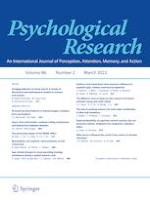22-03-2021 | Original Article
Pictorial low-level features in mental images: evidence from eye fixations
Gepubliceerd in: Psychological Research | Uitgave 2/2022
Log in om toegang te krijgenAbstract
It is known that eye movements during object imagery reflect areas visited during encoding. But will eye movements also reflect pictorial low-level features of imagined stimuli? In this paper, three experiments are reported in which we investigate whether low-level properties of mental images elicit specific eye movements. Based on the conceptualization of mental images as depictive representations, we expected low-level visual features to influence eye fixations during mental imagery, in the absence of a visual input. In a first experiment, twenty-five participants performed a visual imagery task with high vs. low spatial frequency and high vs. low contrast gratings. We found that both during visual perception and during mental imagery, first fixations were more often allocated to the low spatial frequency–high contrast grating, thus showing that eye fixations were influenced not only by physical properties of visual stimuli but also by its imagined counterpart. In a second experiment, twenty-two participants imagined high contrast and low contrast stimuli that they had not encoded before. Again, participants allocated more fixations to the high contrast mental images than to the low contrast mental images. In a third experiment, we ruled out task difficulty as confounding variable. Our results reveal that low-level visual features are represented in the mind’s eye and thus, they contribute to the characterization of mental images in terms of how much perceptual information is re-instantiated during mental imagery.
